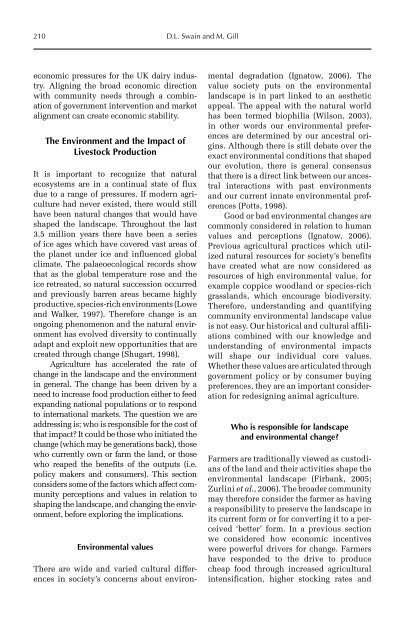Redesigning Animal Agriculture
Redesigning Animal Agriculture
Redesigning Animal Agriculture
You also want an ePaper? Increase the reach of your titles
YUMPU automatically turns print PDFs into web optimized ePapers that Google loves.
210 D.L. Swain and M. Gill<br />
economic pressures for the UK dairy industry.<br />
Aligning the broad economic direction<br />
with community needs through a combination<br />
of government intervention and market<br />
alignment can create economic stability.<br />
The Environment and the Impact of<br />
Livestock Production<br />
It is important to recognize that natural<br />
ecosystems are in a continual state of flux<br />
due to a range of pressures. If modern agriculture<br />
had never existed, there would still<br />
have been natural changes that would have<br />
shaped the landscape. Throughout the last<br />
3.5 million years there have been a series<br />
of ice ages which have covered vast areas of<br />
the planet under ice and influenced global<br />
climate. The palaeoecological records show<br />
that as the global temperature rose and the<br />
ice retreated, so natural succession occurred<br />
and previously barren areas became highly<br />
productive, species-rich environments (Lowe<br />
and Walker, 1997). Therefore change is an<br />
ongoing phenomenon and the natural environment<br />
has evolved diversity to continually<br />
adapt and exploit new opportunities that are<br />
created through change (Shugart, 1998).<br />
<strong>Agriculture</strong> has accelerated the rate of<br />
change in the landscape and the environment<br />
in general. The change has been driven by a<br />
need to increase food production either to feed<br />
expanding national populations or to respond<br />
to international markets. The question we are<br />
addressing is; who is responsible for the cost of<br />
that impact? It could be those who initiated the<br />
change (which may be generations back), those<br />
who currently own or farm the land, or those<br />
who reaped the benefits of the outputs (i.e.<br />
policy makers and consumers). This section<br />
considers some of the factors which affect community<br />
perceptions and values in relation to<br />
shaping the landscape, and changing the environment,<br />
before exploring the implications.<br />
Environmental values<br />
There are wide and varied cultural differences<br />
in society’s concerns about environ-<br />
mental degradation (Ignatow, 2006). The<br />
value society puts on the environmental<br />
landscape is in part linked to an aesthetic<br />
appeal. The appeal with the natural world<br />
has been termed biophilia (Wilson, 2003),<br />
in other words our environmental preferences<br />
are determined by our ancestral origins.<br />
Although there is still debate over the<br />
exact environmental conditions that shaped<br />
our evolution, there is general consensus<br />
that there is a direct link between our ancestral<br />
interactions with past environments<br />
and our current innate environmental preferences<br />
(Potts, 1998).<br />
Good or bad environmental changes are<br />
commonly considered in relation to human<br />
values and perceptions (Ignatow, 2006).<br />
Previous agricultural practices which utilized<br />
natural resources for society’s benefits<br />
have created what are now considered as<br />
resources of high environmental value, for<br />
example coppice woodland or species-rich<br />
grasslands, which encourage biodiversity.<br />
Therefore, understanding and quantifying<br />
community environmental landscape value<br />
is not easy. Our historical and cultural affiliations<br />
combined with our knowledge and<br />
understanding of environmental impacts<br />
will shape our individual core values.<br />
Whether these values are articulated through<br />
government policy or by consumer buying<br />
preferences, they are an important consideration<br />
for redesigning animal agriculture.<br />
Who is responsible for landscape<br />
and environmental change?<br />
Farmers are traditionally viewed as custo dians<br />
of the land and their activities shape the<br />
environmental landscape (Firbank, 2005;<br />
Zurlini et al., 2006). The broader community<br />
may therefore consider the farmer as having<br />
a responsibility to pre serve the landscape in<br />
its current form or for converting it to a perceived<br />
‘better’ form. In a previous section<br />
we considered how economic incentives<br />
were powerful drivers for change. Farmers<br />
have responded to the drive to produce<br />
cheap food through increased agricultural<br />
intensification, higher stocking rates and










